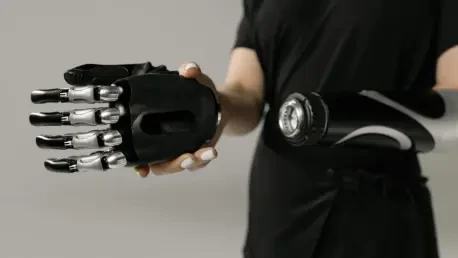Imagine a world where individuals with mobility impairments can prepare a meal entirely on their own, from assembling a pizza to scooping ice cream for a sundae. This vision is becoming a reality through groundbreaking research at Virginia Tech, where a robotic arm equipped with soft grippers has been developed to enhance independence for those with limited mobility. This innovative technology tackles the significant barrier of performing intricate daily tasks, which often require both precision and adaptability.
The central challenge lies in creating a robotic system that can handle the complexity of everyday activities like cooking, which involve manipulating objects of varying shapes and textures. Beyond functionality, a key focus is ensuring that such systems are intuitive and user-friendly, allowing seamless integration into the lives of disabled individuals. This research addresses these hurdles by prioritizing natural interaction between human and machine, aiming to make the robotic arm an extension of the user’s intent.
This advancement represents a pivotal step in assistive technology, offering a glimpse into how robotics can transform mundane tasks into achievable goals for those who face physical limitations. By focusing on user-centric design, the project seeks to redefine what independence means for millions who struggle with routine activities, setting a new standard for innovation in this field.
Background and Importance of Assistive Robotics
Across the United States, millions of individuals with limited mobility encounter daily obstacles that hinder their ability to perform basic tasks without assistance. These barriers, ranging from opening a jar to preparing a meal, often result in a heavy reliance on caregivers, impacting personal autonomy and quality of life. The growing need for assistive technologies has never been more evident as society strives to create inclusive environments for all.
Research into robotic solutions holds immense significance in addressing these challenges, offering tools that can reduce dependence on external help and empower users to reclaim control over their routines. The development of advanced robotic arms contributes directly to broader societal goals of inclusion, ensuring that individuals with disabilities can participate more fully in everyday life. Such innovations are not just about functionality but also about restoring dignity through self-reliance.
Moreover, the impact of assistive robotics extends beyond individual users, influencing how communities and support systems are structured. By providing reliable technological aids, this field fosters a shift toward empowerment, encouraging a cultural perspective that values accessibility and innovation as essential components of equity. This research underscores a commitment to leveraging technology for meaningful social change.
Research Methodology, Findings, and Implications
Methodology
The Virginia Tech team adopted a comprehensive approach to design a robotic arm tailored for assistive purposes, focusing on a hybrid gripper that merges rigid robotic structures with soft, switchable adhesive fingertips. This unique combination allows the arm to grasp a diverse array of objects, from delicate items to heavy cookware, with precision and care. The design process prioritized versatility to meet the varied demands of household tasks.
Integration of artificial intelligence (AI) played a crucial role in enhancing the arm’s functionality, enabling it to interpret user commands through a joystick interface for effective human-robot collaboration. The system was rigorously tested in practical scenarios, such as assembling a pizza and creating an ice cream sundae, to evaluate its performance across different textures and weights. These real-world applications provided critical insights into the arm’s adaptability.
Additionally, the methodology emphasized iterative testing to refine the technology, ensuring that the robotic arm could respond to nuanced user inputs. Collaboration between mechanical engineering experts and AI specialists facilitated a multidisciplinary framework, aiming to balance technical precision with ease of use. This approach laid a robust foundation for assessing the system’s potential in domestic settings.
Findings
Results from the study revealed that the hybrid gripper excelled in handling objects of varying sizes, shapes, and textures, successfully managing everything from soft dough to sturdy metal pans. This versatility proved essential in tasks requiring both gentle handling and a firm grip, demonstrating a marked improvement over conventional robotic designs that often struggle with such diversity.
The incorporation of AI further enhanced the arm’s capabilities, allowing it to learn from user interactions and personalize task execution. For instance, during food preparation activities, the system adapted to individual preferences, such as selecting specific pizza toppings, showcasing a natural and responsive human-robot dynamic. This adaptability underscored the technology’s potential for tailored assistance.
Testing also highlighted the effectiveness of the joystick interface in facilitating smooth operation, enabling users to direct the robotic arm with minimal effort. The successful completion of complex activities, like layering ingredients for a dessert, validated the system’s practical utility in real-life scenarios. These outcomes point to a significant leap forward in creating accessible robotic aids.
Implications
Practically, this technology empowers individuals with disabilities to undertake tasks independently, fostering a sense of autonomy and dignity in their daily lives. By reducing the need for constant caregiver support, the robotic arm enables users to engage in personal activities like cooking, which are often out of reach due to physical constraints. This shift can profoundly impact emotional well-being and self-esteem.
Theoretically, the research contributes to the field of robotics by advancing hybrid gripper technology and AI-driven collaboration. These innovations set a precedent for future assistive devices, offering a blueprint for designing systems that are both powerful and sensitive to user needs. The findings suggest potential applications beyond personal assistance, influencing industrial and medical robotics as well.
Furthermore, the study opens up discussions on integrating such technologies into broader accessibility frameworks, encouraging policymakers and developers to prioritize user-centered solutions. The implications extend to shaping how society views disability, promoting a narrative of capability through technological support. This research paves the way for a more inclusive approach to innovation.
Reflection and Future Directions
Reflection
The research journey revealed several challenges, particularly in the initial stages when the robotic arm struggled to manipulate irregular or exceptionally soft objects. Through persistent iterative testing, the team was able to refine the gripper’s design, improving its ability to handle diverse materials. This process highlighted the importance of resilience and adaptability in technological development.
Another area of consideration was the user interface, which required multiple adjustments to ensure accessibility for individuals with varying degrees of mobility impairment. Feedback from test scenarios was instrumental in enhancing the joystick’s responsiveness, making the system more intuitive. These efforts underscore the necessity of involving end-users in the design phase to address real-world needs.
Looking back, there remains room for deeper exploration into expanding the range of tasks the robotic arm can perform. Refining the balance between automation and user control could further enhance its applicability across different contexts. Such reflections provide valuable lessons for ongoing and future projects in assistive robotics.
Future Directions
Moving forward, the research team envisions developing robotic systems capable of manipulating any object, regardless of its unique characteristics, to create truly universal assistive tools. This ambitious goal, supported by funding from the National Science Foundation, aims to address even the most complex challenges in object handling over the coming years, from 2025 to 2027.
There is also a pressing need to focus on personalization, ensuring that robotic arms can be customized to meet the specific preferences and requirements of individual users. Scalability remains a priority, with plans to adapt the technology for diverse populations and environments, making it accessible on a wider scale. These steps are crucial for maximizing impact.
Additionally, exploring partnerships with healthcare providers and accessibility advocates could accelerate the integration of such systems into everyday life. Future research might delve into combining sensory feedback mechanisms to enhance the user experience, providing tactile cues during operation. These directions aim to build on current successes, pushing the boundaries of what assistive robotics can achieve.
Transforming Lives Through Robotic Innovation
The exploration into robotic arms with soft grippers at Virginia Tech marked a transformative moment in assistive technology, demonstrating how such innovations could significantly enhance independence for individuals with mobility impairments. The hybrid design, coupled with intuitive AI and user-friendly interfaces, successfully empowered users to tackle complex daily tasks, from meal preparation to dessert creation, with newfound autonomy.
These advancements not only showcased the potential of robotics to handle diverse objects but also set a benchmark for future developments in the field. The emphasis on user-centric interaction ensured that technology served as a genuine extension of human capability, rather than a detached tool. As a result, the project redefined possibilities for those facing physical challenges.
Looking ahead, actionable steps included scaling up the technology through broader testing and collaboration with community stakeholders to ensure real-world applicability. Continued investment in personalization and the integration of advanced sensory features stood out as critical next steps to refine user experience. This research inspired a forward-thinking approach, encouraging the assistive technology sector to innovate relentlessly toward a more inclusive future.









